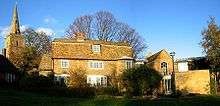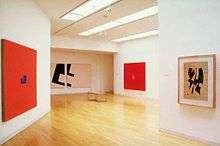Kettle's Yard

Kettle's Yard is an art gallery and house in Cambridge, England.[1] The director of the art gallery is Andrew Nairne. Both the house and gallery are currently closed for expansion of the facilities.
History and overview
Kettle's Yard lies on the west side of Castle Street, between Northampton Street and St Peter's Church.
It was originally the Cambridge home of Jim Ede and his wife Helen.[2] Moving to Cambridge in 1956, they converted four small cottages into one idiosyncratic house and a place to display Ede's collection of early 20th-century art. Ede maintained an 'open house' each afternoon, giving any visitors a personal tour of his collection.
In 1966, Ede gave the house and collection to the University of Cambridge, but continued living there before moving to Edinburgh in 1973.[3] In 1970, the house was extended, adding an exhibition gallery in a contrasting modernist style by Leslie Martin.
Today, the house is preserved as the Edes left it, making a very informal space to enjoy the permanent collection and live music.[4] An appeal to help extend and enhance the gallery raised £8,000,000; it was announced on 29 March 2011 that the Heritage Lottery Fund had granted £2,320,000 for the project.[5] The house and gallery temporarily closed in June 2015 while the major building project to create a four-floor education wing, improved exhibition galleries, a new entrance area and a café is carried out. The development is expected to take two years.[6] During the closure, there will be displays of the collection at the Fitzwilliam Museum in Cambridge and the Jerwood Gallery in Hastings.
Kettle's Yard is part of the University of Cambridge Museums consortium.[7]
Permanent collection

The permanent collection is composed of paintings, sculptures and objects collected by Ede. It is largely based on associations and friendships formed when Ede was curator at Tate Gallery, and as such it is biased towards works from the British avant-garde of the first half of the 20th century.
Ian Hamilton Finlay described Jim Ede's 'fusion of art and found objects' on an inscribed pebble as' the Louvre of the pebble'[8]
Notable artists represented in the collection are:
- William Congdon
- Ben Nicholson
- Henri Gaudier-Brzeska
- Ian Hamilton Finlay
- Barbara Hepworth
- Henry Moore
- Winifred Nicholson
- Christopher Wood
- Alfred Wallis
- Constantin Brâncuși
- Joan Miró
- David Jones
See also
- Primavera Gallery on King's Parade, has put on several exhibitions at Kettle's Yard
- Wysing Arts Centre, a research and development centre for the arts, west of Cambridge in Bourn
References
- ↑ Kettle's Yard, Culture 24, UK.
- ↑ http://www.kettlesyard.co.uk/house/index.html
- ↑ http://www.kettlesyard.co.uk/house/index.html
- ↑ http://www.kettlesyard.co.uk/music/subs.html
- ↑ http://www.admin.cam.ac.uk/news/dp/2011032902
- ↑ KY developmentplans
- ↑ http://www.cam.ac.uk/museums-and-collections/visit-us/our-museums
- ↑ Exhibition catalogue 'Beauty and Revolution: The Poetry and Art of Ian Hamilton Finlay' Kettles Yard, Cambridge 2014
External links
- Kettle's Yard Gallery website
- Kettle's Yard House
- Kettle's Yard Collection
- Video conversation between Roger Wilson and Paul Coldwell to accompany the exhibition 'Paul Coldwell: I called while you were out' 2008/9
- "The Analysis of Beauty" by Disinformation at Kettle's Yard on YouTube
Coordinates: 52°12′39″N 0°06′51″E / 52.2109°N 0.1141°E